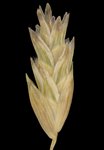
T. vanleeuwenii spikelet.
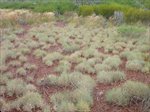
T. vanleeuwenii habitat.
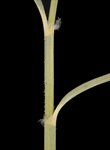
T. vanleeuwenii orifice and sheaths with sparkling droplets.
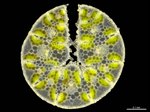
T. vanleeuwenii leaf section.

T. vanleeuwenii inflorescence.
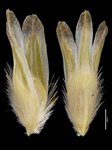
T. vanleeuwenii lemmas.

T. vanleeuwenii paleas.

T. vanleeuwenii map.
Name
Triodia vanleeuwenii B.M.Anderson & M.D.Barrett, ined.
Citation
Austral. Syst. Bot., in press, (2017)Derivation
vanleeuwenii — in honour of Dr. Stephen van Leeuwen (1962–), Western Australian biologist who has worked extensively in the Pilbara.Common name
van Leeuwen’s Spinifex
Synonyms
Triodiasp. Shovelanna Hill (S. van Leeuwen 3835)Diagnostic features
Hummocks small, 15–50 cm tall; foliage non-resinous; leaf sheath surfaces glabrous or hairy, young sheaths with minute sparkling colourless droplets; orifice hairs woolly; leaf blades 4–9(–11.5) cm long, amphistomatous (hard-type), usually blue-green when fresh; inflorescences branched or unbranched, with 0–3(–5) branches bearing more than one spikelet and 5–9(–14) spikelets total; lower glume elliptic, 6–12-nerved; lowest lemma lobed for about half its length, not awned, bitextured; midlobe of lowest lemma 2.8–4 mm long; on rocky slopes or flats, or occasionally on loam flats seemingly without rock, in the eastern Hamersley Range from Karijini National Park east, and the Little Sandy Desert.
Habitat
Occurs on ironstone ridges and rocky or gravelly slopes or rises, occasionally very low in the landscape and seemingly on flat loam plains, but these likely with subsurface rocky substrates.
Distribution and frequency
Restricted to the eastern Hamersley Range, from Karijini National Park east, and also a few hills to the east of Newman, and a disjunct location in the Little Sandy Desert.
Similar species
Triodia vanleeuwenii is a member of the Basedowii group, sharing the group features of non-resinous foliage, amphistomatous (hard-type) leaf blades and many-nerved (≥6) glumes.
Most similar to two other short-leaved members of the group, T. chichesterensis and T. scintillans, both of which occur on the north side of the Fortescue River, and do not overlap in distribution with T. vanleeuwenii to the south. Triodia chichesterensis lacks the minute colourless droplets diagnostic for T. scintillans and T. vanleeuwenii, and has lemma midlobes that are 4.2–8 mm long and hairy (2.2–5.2 mm long and glabrous in T. scintillans and T. vanleeuwenii). Triodia vanleeuwenii is very similar to T. scintillans, but has inflorescences with 5–9(–14) spikelets, 0–3(–5) branches bearing more than one spikelet (inflorescences with 7–19 spikelets, (1–)2–7 branches bearing more than one spikelet in T. scintillans), and usually blue-green foliage in active growth (usually bright green in active growth, but becoming bluish under drought stress in T. scintillans); distribution immediately separates them.
Triodia basedowii, T. glabra and T. lanigera can usually be separated by having longest leaves >14 cm long (longest leaves usually 4–9(–11.5) cm long in T. vanleeuwenii), and, except for T. basedowii, in non-overlapping distribution (see Identification without florets below for further notes on separation from T. basedowii).
Triodia infesta, T. mallota and T. plurinervata can be distinguished by having unbranched inflorescences with very short pedicels <3 mm long (branched to unbranched, with the longest basal pedicels >3 mm long in T. vanleeuwenii), and by disjunct distributions.Conservation status
Not considered at risk.
Identification without florets
Triodia vanleeuwenii is the only Basedowii group species occurring in the eastern Hamersley Range. Plants occurring on scarcely raised rocky rises in the southern Fortescue sub-region can occur immediately adjacent to plants of T. basedowii, and can then be distinguished by possessing minute colourless droplets on young sheaths (absent in T. basedowii), having smaller leaves usually 4–9(–11.5) cm long (longest leaves usually >15 cm long in T. basedowii), and orifice hairs not spreading onto the leaf blade (spreading onto the base of the blade in T. basedowii). Other distinguishing characters include less branched inflorescences with 5–9(–14) spikelets and 0–3(–5) branches bearing more than one spikelet [(10–)13–54 spikelets and (2–)4–10 branches bearing more than one spikelet in T. basedowii], and usually blue-green colour of foliage in active growth (dull green in T. basedowii).Variation
A fairly uniform species. Most plants are distinctly blue-green in active growth (often also with purplish pigment on the sheaths), but a few dull green plants sometimes occur in a predominantly blue-green population.
A population near Coondiner Pool on the Roy Hill Road shows signs of past introgression with T. scintillans (Anderson et al 2016).
Notes
Triodia vanleeuwenii was treated under a broad concept of T. basedowii by Lazarides (1997), Lazarides et al. (2005) and Ausgrass (Sharp & Simon, 2002; Simon & Alonso, 2014).
A full description of T. vanleeuwenii is available in Anderson et al. (2017a).
Plants appear to be always killed by fire, never resprouting (Casson & Fox,1987 as T. basedowii; MB & BA observations).